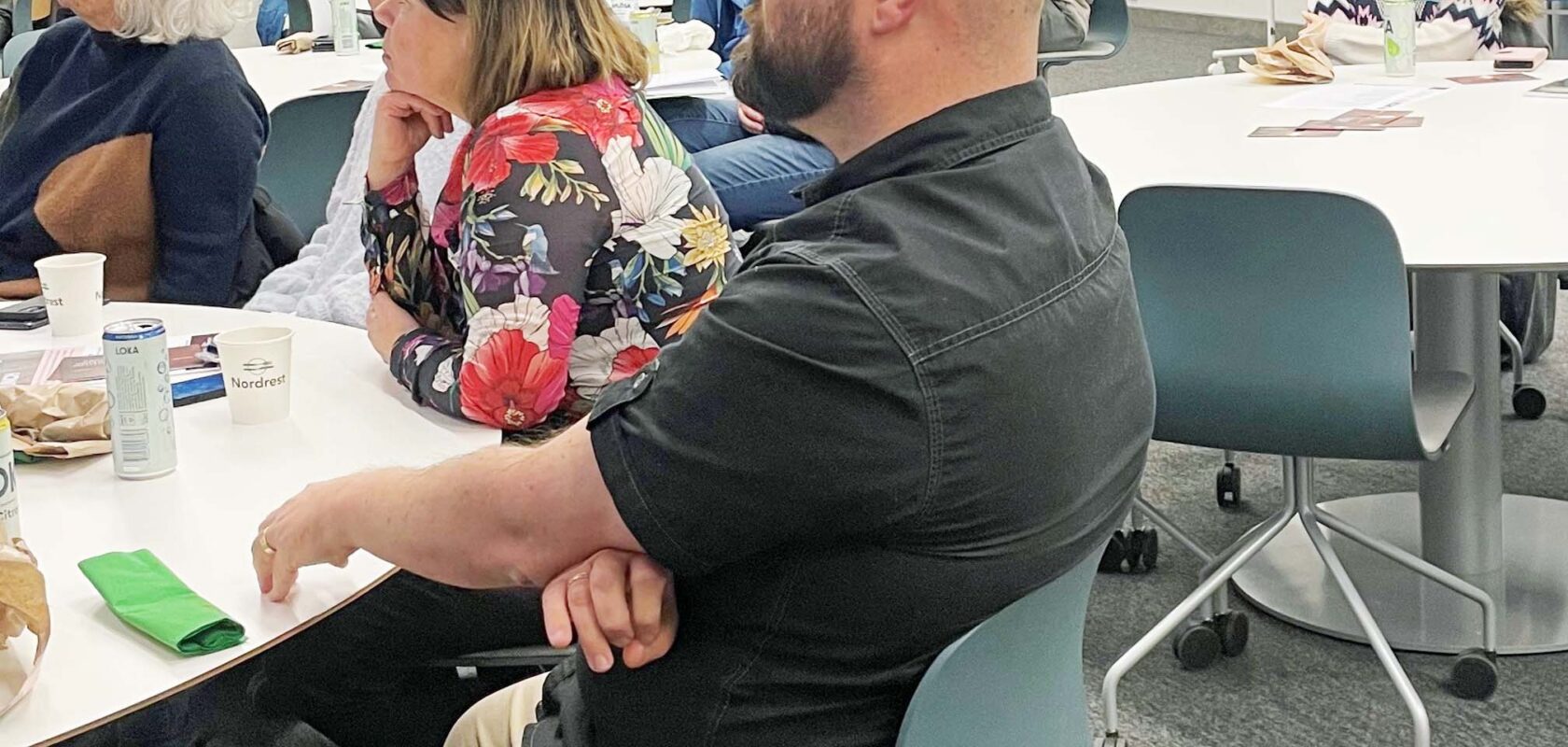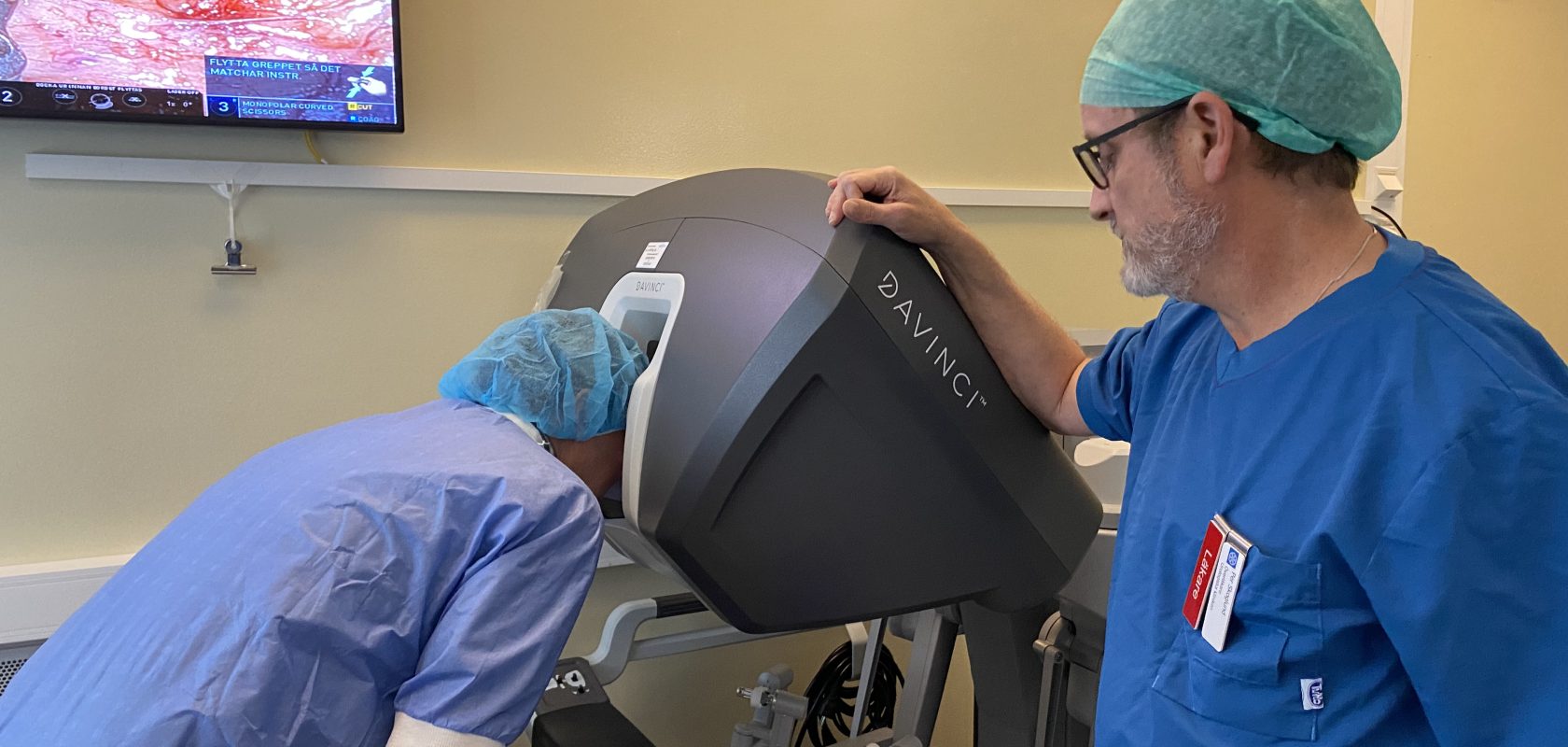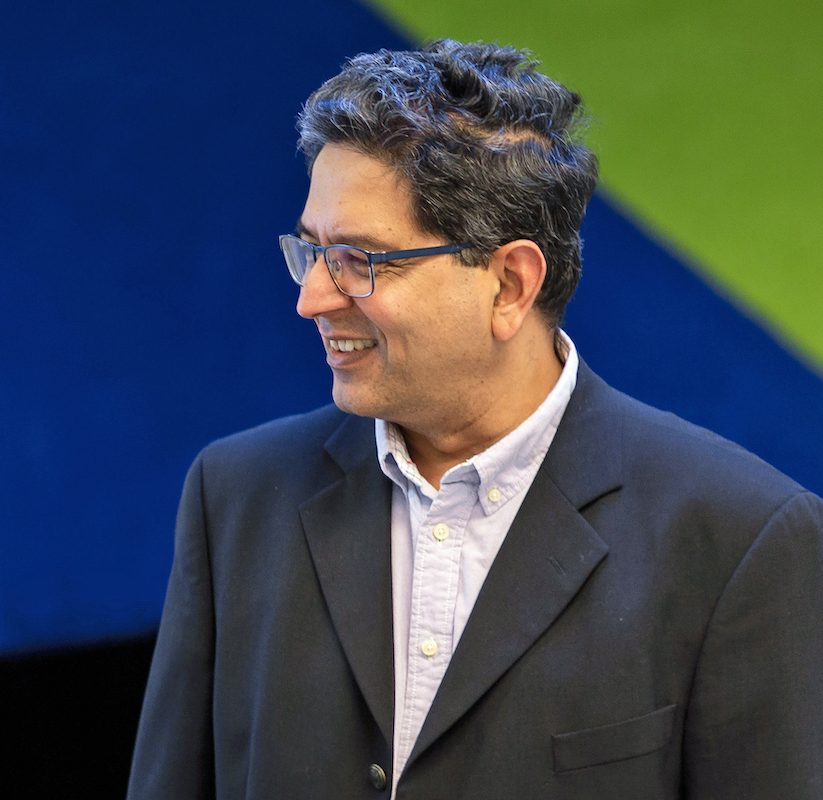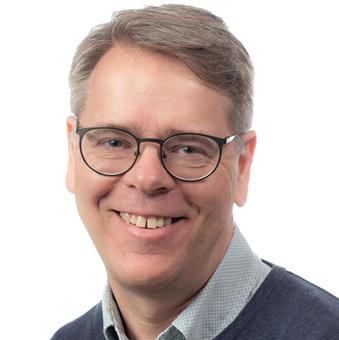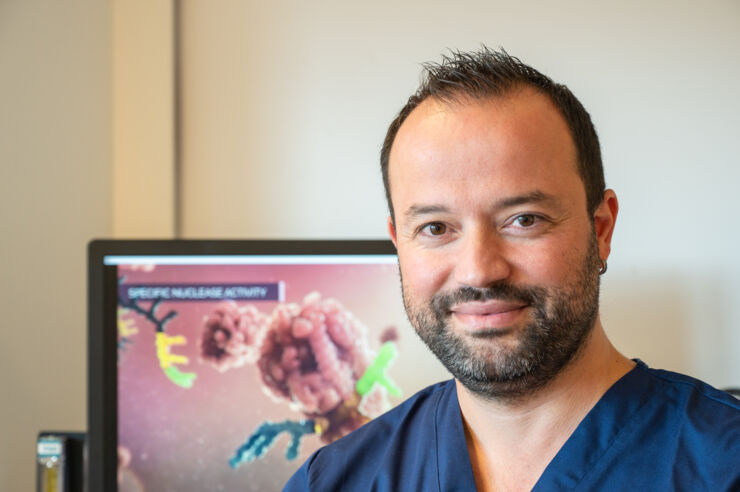A smooth and straightforward meeting place for clinicians, academics, and researchers. That’s the core idea behind Innovator’s Lunch.
“This type of informal meeting is beneficial both for learning and development,” says Annika Bergström, project manager at East Sweden Medtech and initiator of the lunch concept.
Since the launch of Innovator’s Lunch in spring 2023, many important topics have been discussed – robotics, 3D/AM, digital twins, self-monitoring, and materials research, to name a few.
The goal is to invite two speakers to each session, one from academia and one from healthcare.
“We often have fairly broad themes, and it becomes interesting with two different approaches to the topic,” says Annika Bergström.
She cites self-monitoring as an example.
“Then, Petra Jacobson, a specialist nurse at the Pulmonary Medicine Clinic, shared her perspective on the work of involving patients more in their own care, and Professor Mattias Elg, who among other things, researches efficiency and quality development in healthcare, provided his research-based perspective.
I know they learned a lot from each other.”
Now, the first meeting after the summer is approaching. On September 17th, the tables will be set with a light lunch, and the discussion topic will be “Close Care.” Among those present will be Niclas Hilding, head of Primary Care in the central part of Östergötland County.
“Close Care means that the staff’s work is based on the patient’s conditions. We will discuss the possibilities of moving more care to the home,” says Annika Bergström.
“We haven’t finalized the autumn themes yet, but cybersecurity might be one of them,” she continues.
East Sweden Medtech’s role in the lunches is to capture identified needs in healthcare and help connect them with new technology, new platforms, or new fields, or for that matter, with existing technology that can be beneficial.
And Annika would like to see more concrete needs highlighted during the autumn lunches.
“My hope is that more needs from clinical practice will be raised. Maybe someone has an idea that needs to be pitched? Preferably someone who works in the field and has a clear request for a product or method that can improve the work,” she says.
“There will be academics and researchers present to listen, and they need to hear this directly from those who need a smart and innovative solution. This way, important connections can be made – exactly as intended with Innovator’s Lunch.”
Do you have an idea that you would like to bring up during a lunch?
Feel free to contact Annika Bergström at annika.bergstrom@eastswedenmedtech.se.
East Sweden Medtech’s study visit to Linköping University Hospital provided a close-up view of how robotic surgery works at Anopiva.
– To be the clear link between healthcare, research, and innovators, we need to have insight into healthcare’s needs, and this was a very rewarding day, says Terese Källberg, ESMT’s operational manager.
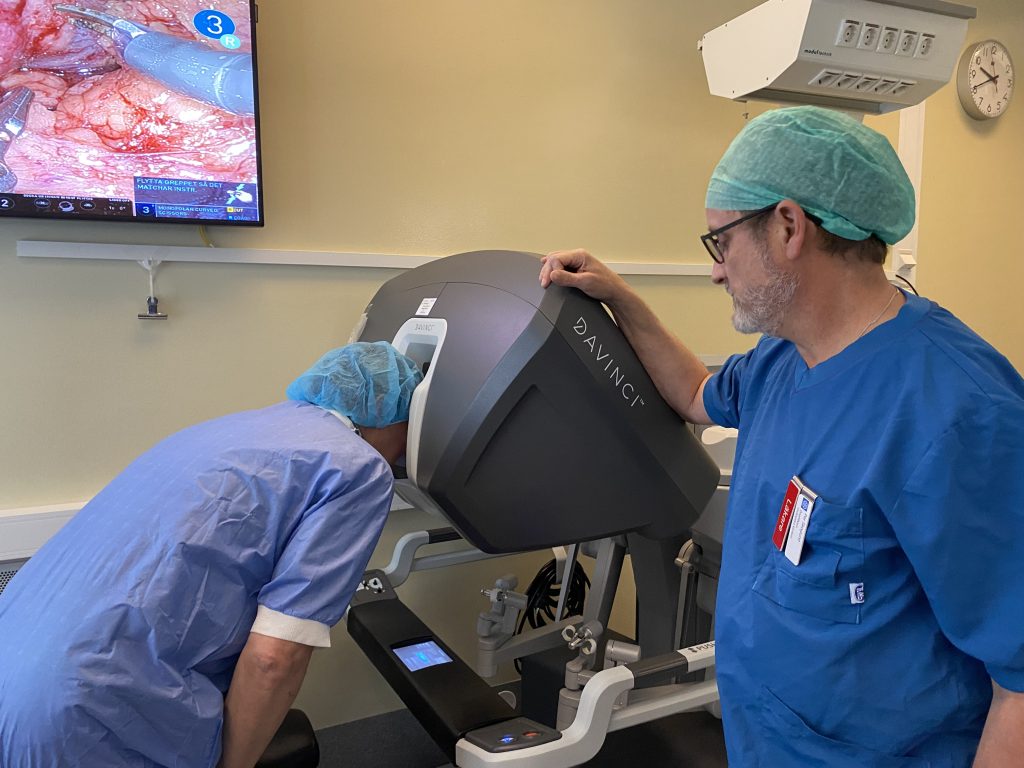
A concentrated effort is ongoing around the patient, who is lying anesthetized on the table in the operating room. The woman, who is in her 60s, is about to have a tumor removed by the arms of the Da Vinci robot. The tumor is located on one kidney, and with the help of the technology, Chief Physician Per Skoglund can turn and twist the kidney, thereby accessing the tumor much more easily and at the same time much more advancedly than with open surgery.
– Apart from the costs, there are really only advantages to robotic surgery,” says Per. “Not least for the patient, who experiences a significantly smaller procedure and therefore recovers faster and can leave the hospital after just a day or so, often with only Panodil for pain relief instead of stronger medications.
The care time after kidney surgery has been halved thanks to the technology, and the faster recovery leads to shorter sick leave for the patient. Another advantage is that it is possible to perform surgical procedures later in life.
– The reduced operation trauma means that we can now also operate on patients who have fewer resources to handle large operations, says Per.
The first robot came to Anopiva (anesthesia-operation-intensive care) in 2007, and Linköping University Hospital was then the fourth hospital in Sweden to gain access to the technology. Today, nearly 95 percent of urological surgery is performed with the help of robots.
Operates via 3D image

Per takes off his clogs and sits in the actual control cabin. He leans over a small screen where he sees the part of the abdomen he is going to operate on in a clear 3D image. With hands and feet, he controls the robot while talking into a microphone with the team working around the patient. On TV screens in the operating room, the staff can follow everything that happens.
The procedure goes in the number of minutes that Per planned. Fast and efficient. The possibilities with the technology are almost endless, yet the adjacent room stands empty, with an idle robot.
The clinic’s needs are about personnel resources.
– It’s partly a personnel issue, partly a planning issue,” says Per Skoglund. “Right now, the equipment is not being used to its full potential. In an ideal world, we would have more of an ‘airplane thinking’ which means that the robot stands still as little as possible, but that doesn’t work with the current personnel situation.”
In addition, more clinics want more time for robotic surgery. The surgical clinic and the gynecological clinic are two examples.
Smoother in every step
To find a solution to the nurse shortage, the anesthesia department at Anopiva started a project after New Year that involves streamlining the routines for prostate cancer operations, radical prostatectomy.

– The work goes smoother at every step,” says Sara Loumala, anesthesia nurse. Everyone knows exactly what to do and where to stand in the room during an operation. We have thereby shortened the time from what we call knife in, to knife out. Additionally, preparations for an operation go faster. This has meant that we can operate on three patients a day, instead of two, and that the care queues have been significantly reduced.”
A clear example of how needs create solutions.
– It is very useful for us to go out and see what the employees’ everyday life looks like,” says Anders Brodin, East Sweden Medtech’s project manager. The more we learn, the easier it becomes to understand the business, and we benefit greatly from this in meetings and interviews with healthcare staff.
Close view of healthcare
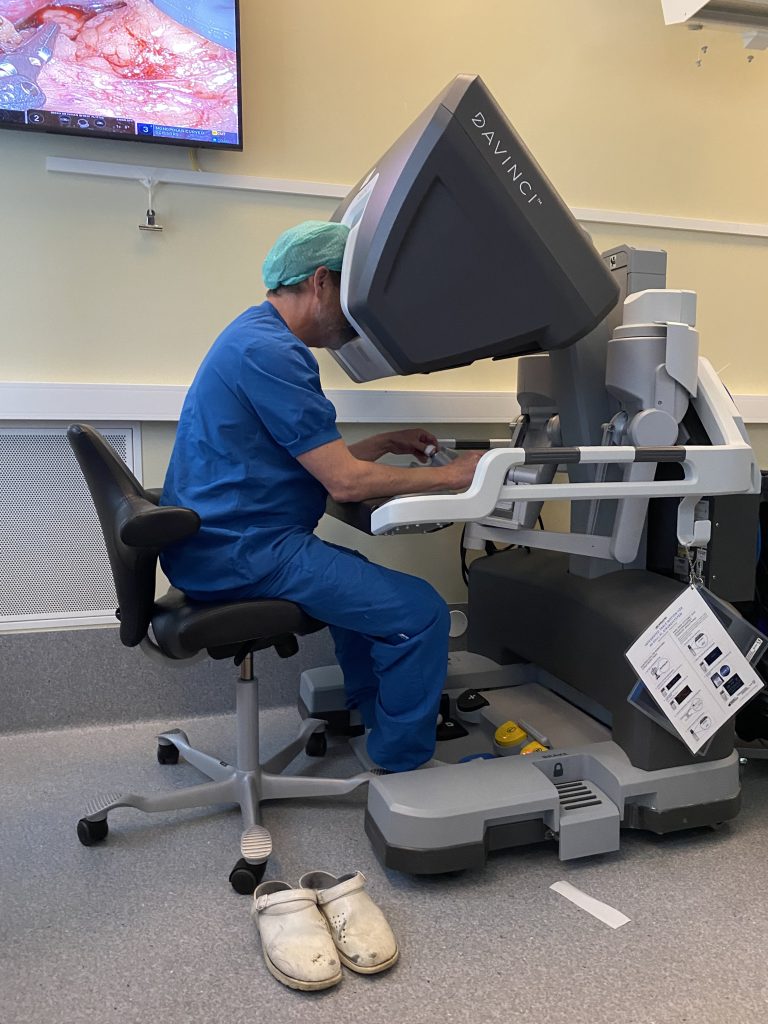
The study visit continued with a tour of various departments, including the intermediate care unit CIMA. There, intensive care nurse Katarina Solnevik talked about the newly started department, which receives patients who do not need care in intensive care but are not ready to be moved to a ward.
– The purpose of this day was to create a close-up view of healthcare and gain a deeper insight into various needs where we from ESMT can participate and support, concludes Annika Bergström, project manager.
Professor Srinivas Uppugunduri has been interested in the body’s healing process ever since he started his research career. He is now receiving 50,000 SEK from the VFN program to test a self-developed cream that can reduce inflammation in the skin.
Srinivas Uppugunduri works at the Regional Cancer Center, Southeast, in Region Östergötland, where he is Head of Operations. He has a PhD in clinical chemistry and is an adjunct professor at Linköping University. Through his research, he has discovered substances that have both anti-inflammatory and moisturizing effects.
Why have you chosen this particular area?
– Imagine you get a wound on your finger. The first thing that happens is that your white blood cells make their way to the wound and start tackling it. But how do the white blood cells know exactly where to go?
– I usually say that the immune system is as close to religion as you can get. It’s amazing! The body takes care of minor injuries and often you don’t even notice that you have a problem. But sometimes the system doesn’t work, and then it can instead become a big problem. In those cases, the white blood cells may need help being directed correctly, and I want to help ensure that.
Tell us more about your research?
– Initially, I took cells from the umbilical cord of newborn children. I cultured the cells further and looked at the binding of white blood cells. There I discovered the substances that can both relieve and heal inflammations and at the same time moisturize the skin.
What will you use the VFN funds for?
– I want to test the cream in three different groups; one group that has problems with eczema, one that is treated for sun damage, one that has burn injuries after tattooing, or irritation or inflammation of the skin after radiotherapy.
– The radiotherapy that cancer patients receive can cause inflammation, and I would like to distribute free samples to that patient group so that they can use the cream and return with feedback.
What needs in healthcare does your research meet, and what is the benefit for the patients?
– There are already creams in healthcare, but they contain steroids which means they hit too broadly. Our cream contains completely harmless substances and therefore patients can use them for long periods.
Footnote: VFN stands for Verification for Utilization and is a program at Linköping University for activities that contribute to research results creating benefits. East Sweden Medtech finances four of the VFN projects.
A large proportion of patients examined with magnetic resonance imaging experience discomfort. Radiographer and researcher Johan Kihlberg is investigating whether internet-based CBT can be helpful. Now he is receiving SEK 50,000 from the VFN programme to conduct a study.
Johan Kihlberg is a nurse and has further trained as a radiographer. He works at the radiology department at Linköping University Hospital.
Why did you choose this particular area?
– It is precisely in radiology that technology, medicine and nursing meet, and the development in each part affects the other parts. As a researching radiographer, I get the opportunity to work with extremely competent engineers and physicists and with doctors, psychologists, physiologists and nurses. It is very inspiring, fun and educational.
Tell us more about your research?
– Almost a third of patients who need to have an MRI experience discomfort. There are various reasons for the discomfort that we can call tightxiety. For some patients, the congestion is so severe that they need to be anesthetized. Technological advancements have resulted in more patient space and faster imaging, but that’s not enough.
– Cognitive behavioural therapy (CBT) has been shown to be effective in areas such as fear of dental examinations. A more accessible method is internet-based CBT (iCBT), which has had good results for various phobias and depressions. The goal of this study is to evaluate a customized iCBT for patients who have difficulty performing MRI scans.
What are you going to use the VFN money for?
– They will be used when we map out how common MRI strains are in the south-eastern healthcare region. After that, we will adapt iCBT for MRI strictest and do a randomized controlled trial with people who have experienced MRI stricture.
What needs in healthcare does your research meet, and what are the benefits for patients?
– Patients who experience congestion can be helped to complete the MRI scan. They can also be helped with similar situations in life, such as other medical examinations such as CT scans or scintigraphies. Those who suffer the most from the most crowded conditions may also be able to be helped with more everyday situations such as riding the elevator.
Footnote:
VFN stands for Verification for Utilisation and is a programme at Linköping University for activities that will contribute to the benefit of research results. East Sweden Medtech finances four of the VFN projects.
Researcher Baris Ata Borsa’s new technique produces antibiotics that uniquely kill pathogens in the body causing infection.
– With this technology, we can offer a safer treatment with fewer side effects for patients with cancer or severe infections, he says.
Baris Ata Borsa is a clinical microbiologist and has worked as a specialist in various hospitals for more than ten years before coming to Sweden to participate in a drug development project. Now, he receives 50,000 SEK from the VFN program to explore the possibilities of creating a company around his drug development platform.
Why have you chosen this area?
– Since the beginning of my career, I have been interested in antimicrobial resistance (AMR). Multidrug-resistant pathogens are one of the most critical threats to humans today. It’s a challenge that must be addressed, and I decided to be part of the fight.
Tell us about your research?
– My research focuses on developing innovative antimicrobial agents to combat AMR. This is extremely important because 4.95 million people died in 2019 from diseases where bacterial AMR played a role. Of these, 1.27 million were directly due to AMR. If left unchecked, it is estimated that ten million people could die each year due to AMR by around 2050.
– In my project, we are developing a platform technology that produces antibiotics targeted at pathogens causing disease. This means that the antibiotics circulate in the body like a GPS, searching for the pathogen, without harming any other bacteria or the patient’s body. When the antibiotics reach the infection site, they will be activated to kill the pathogen and treat the infection.
What will you use the money for?
– We need to find a way to enter the market, and the grant will be used to investigate how we can create a company around our technology.”
What needs in healthcare does your research address, and what are the benefits for patients?
– Our platform has the potential to make a significant change in the treatment of infectious diseases and cancer. If successful, thanks to our targeted treatment strategy, patients with drug-resistant infectious diseases will have a new chance, and cancer patients will be treated in a safer manner with fewer side effects.
Footnote: VFN stands for Verification for Utilization and is a program at Linköping University for activities that contribute to research results creating utility. East Sweden Medtech finances four of the VFN projects.
Skin injuries are challenging, not only because they cause pain, but also because they are psychologically taxing. Doctoral student Sallam Abdallah aims to understand the wound healing process using stem cell-based therapy. Now, she receives 50,000 SEK from the VFN program to continue her research.
Sallam Abdallah obtained her master’s degree in biology from The Hashemite University in Jordan. She then worked as a research assistant in the Human Genetics and Stem Cell group at the University of Sharjah, United Arab Emirates, before beginning her doctoral studies in 2021 at Linköping University.
Why did you choose this area?
– The ability of stem cells to develop into different cell types can help unveil the mysteries of regeneration and repair in the human body. I am extremely excited about this project because my scientific research interests lie within stem cells and translational research.
– Linköping University is a highly active research and educational environment, with a worldwide reputation and great potential. I am impressed by the close collaboration between the university and the university hospital, where our research findings extend beyond the boundaries of research labs and scientific papers and are applied clinically.
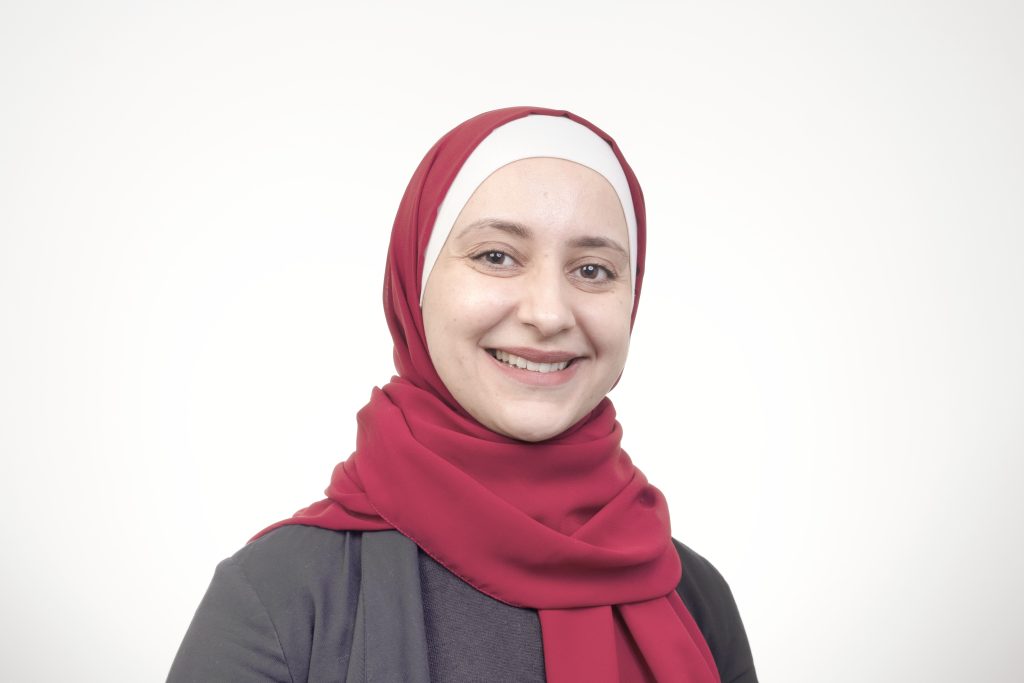
Tell us about your research?
– Stem cells extracted from adipose tissue can be transformed into various cell types. This means they can be highly beneficial in the wound healing process.
– Investigating the effect of epigenetic modifications on adipose-derived stem cells in combination with three-dimensional structure will help us overcome the obstacles in the treatment of skin diseases and around wound healing and burns.
What will you use the money for?
– We want to build a portal where knowledge is translated into real applications. Through multidisciplinary research, we bring together academia, industry, and healthcare.
– Additionally, we will explore the possibility of integrating commonly used biomaterials for clinical dressings with our intervention, which could significantly improve the healing process.
What needs in healthcare does your research address, and what is the benefit for patients?
– We aim to reduce the risk of patients experiencing complications during the healing process. Thus, we hope that the need for long stays in healthcare facilities will decrease significantly.
– Surgeons and nurses who currently spend a lot of time and effort on surgical therapy and skin grafts will also benefit from our results. Moreover, our work may have socio-economic benefits, as the costs of treating difficult wounds are predicted to decrease.
Footnote: VFN stands for Verification for Utilization and is a program at Linköping University for activities that contribute to research results creating value. East Sweden Medtech funds four of the VFN projects.
